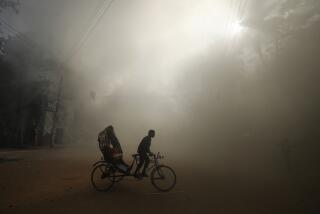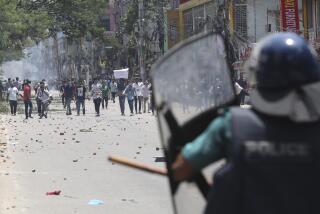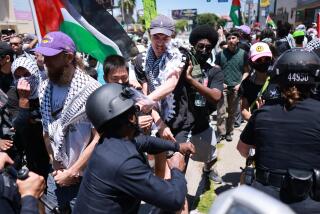4 Killed, 500 Jailed in Day of Protest Across Pakistan
RAWALPINDI, Pakistan — As President Pervez Musharraf arrived in the United States for weekend meetings with American leaders, a nationwide strike called by fundamentalist religious parties back home in Pakistan brought business to a standstill and sparked violent confrontations with police Friday, leading to at least four deaths and more than 500 arrests.
Despite the near-universal observance of the strike and the pockets of violence, officials said they were pleased by the relatively small size of the anti-government demonstrations.
To prepare for the day of protest, described by organizers as a test of the Musharraf government’s stability, police made dozens of preemptive arrests of potential troublemakers. Back-alley deals were made between police and demonstrators to allow limited political haranguing before riot squads wielding bamboo sticks moved in.
“The crowds were small. This shows lack of public interest in disruptive action,” said Interior Secretary Tasneem Noorani. “It shows how small the elements creating trouble are.”
The government also declared the day a national holiday in honor of poet and philosopher Allama Iqbal, giving shopkeepers an excuse to shutter their businesses.
Leaders of the main pro-Taliban religious party, Jamiat-ul-Ulema-e-Islam, declared the day of protest a success.
“The strike was 100% effective,” said Maulana Abdulghaffor Haideri, party general secretary. “Most of the streets and main arteries were closed. It is a sign that the people have rejected Musharraf’s policies.”
The biggest confrontation Friday was in Dera Ghazi Khan, a city in the southern province of Punjab, where police opened fire on 6,000 demonstrators attempting to block a major national rail line. Four people died and several others were wounded in the incident, which continued late Friday after Jamiat-ul-Ulema-e-Islam supporters took two police officers hostage. When two negotiators were sent into the crowd to try to win the captives’ release, they were also taken hostage.
In this northern military headquarters city, police and demonstrators battled into the night in a congested market area.
Duel With Bricks and Tear Gas
Racing down the narrow alleys of Rawalpindi’s Chittian Hattian market, the two sides played cat and mouse, dueling with tear gas and bricks heaved from nearby construction sites. Youthful demonstrators set fire to tires and stacks of boxes.
Similar confrontations took place in Karachi, where tear gas was used to disperse more than 2,000 demonstrators.
Because of elaborate security preparations, relative calm was maintained in most other major cities, including the fundamentalist strongholds of Quetta and Peshawar.
In Quetta, religious political parties and the regional police had struck a deal to make the strike the focus of the day, rather than the usual noisy Friday processions replete with speeches and the burning of effigies of Musharraf and President Bush.
Also keeping the streets quiet was an enormous show of force by local police, paramilitary forces and soldiers, as well as the arrest of about 50 people the day before, including two leading figures in the local political parties.
Quetta Inspector General Shoaib Suddle said there were 2,000 police on the streets, more than three times the usual number but a necessity in what he called “the most sensitive city in Pakistan” because of its proximity to the Afghan border and the activity of religious parties.
Friday morning in Peshawar, a smattering of police faced a restless crowd. Men raced in the winding shadows of the market, ordering shopkeepers to shutter their stores.
Police fired tear gas into the crowds and arrested 25 of the rowdiest protesters.
At noon, policemen and fundamentalist leaders huddled together in a cool alley behind a 200-year-old mosque. They leaned side by side, uniforms alongside robes, arms slung around shoulders. They laughed while they negotiated.
Deal Clears Way for Demonstration
They agreed that demonstrators would be allowed to march from the mosque around the corner, past the knots of fig and nut peddlers, past the shuttered goldsmiths. When they reached Memorial Square, they could give political speeches--as long as they used no loudspeakers.
With the rules set, the men nodded, hugged one another and parted ways. The Islamic politicians slipped back into the mosque; the policemen strode off to instruct their troops.
The demonstrators burst from the old mosque with a great shout, hoisting banners, fists thrust toward the sky. The journalists waited outside among the donkeys.
“Dog, dog, Bush, Bush!” the protesters cried. “God is great!”
A few blocks away, a second, angrier mob hoisted banners in English--the better for foreign cameras. The political leaders were nowhere to be found, and the demonstrators used banned loudspeakers to blare history and politics over the sagging old rooftops.
This was political theater, ugly by turns: A young boy waved an Osama bin Laden poster over the crowd. An effigy of British Prime Minister Tony Blair was beheaded, hacked to bits and burned; demonstrators hooted, pushed and taunted a mentally disabled man.
Clad in riot gear, clutching shields, rifles and thick sticks, lines of police squared off against the demonstrators. Exhilarated with the calls to holy war, protesters rushed the police--but clashes went no further than shouting and shoving matches. The demonstrators finally retreated when police drew their guns.
Clouds of dust and smoke still hung in the air as the speakers urged the men to Peshawar’s mosques for prayer.
*
Tempest reported from Islamabad and Rawalpindi, Rubin from Quetta and Stack from Peshawar.
More to Read
Sign up for Essential California
The most important California stories and recommendations in your inbox every morning.
You may occasionally receive promotional content from the Los Angeles Times.










